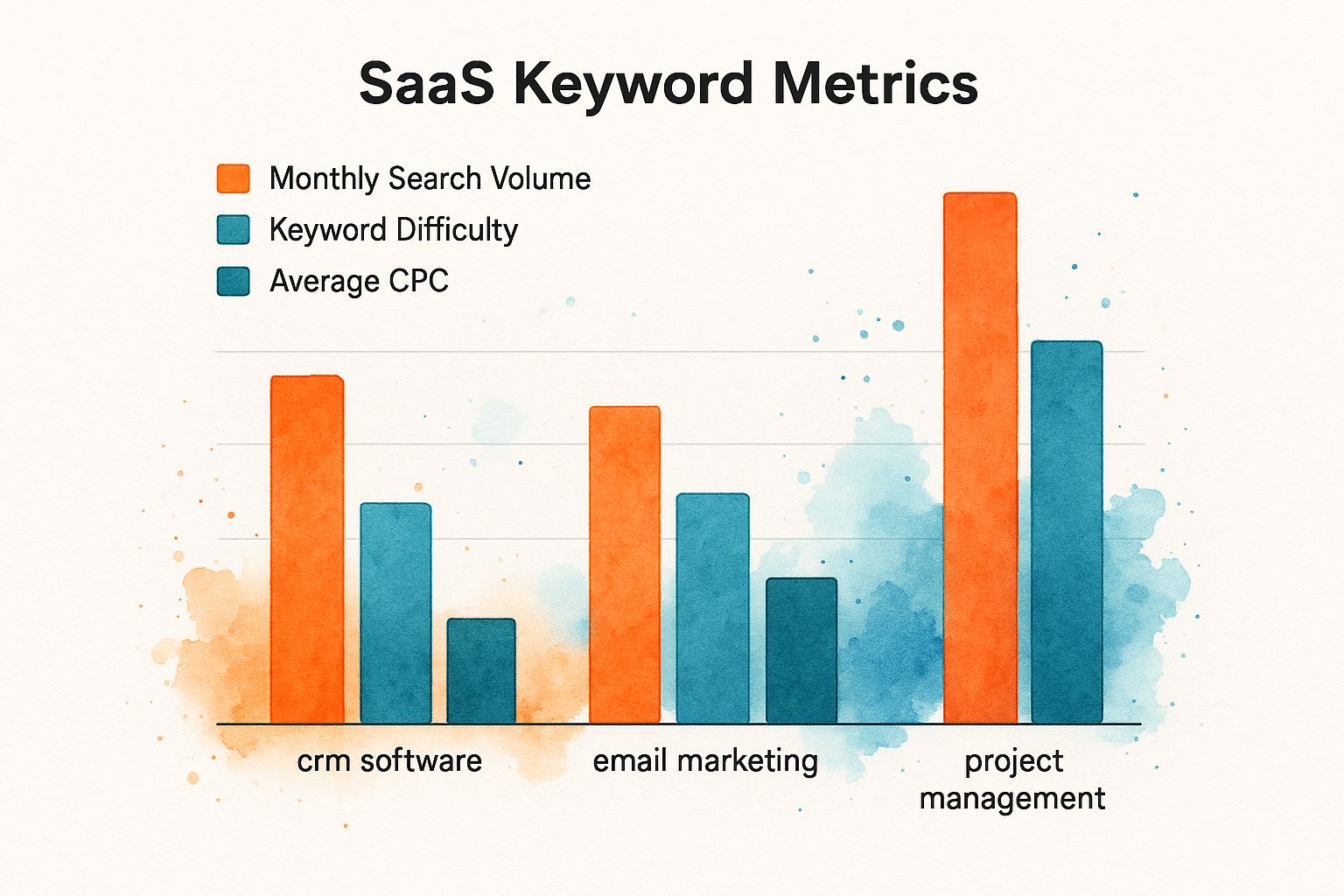Keyword Research for SaaS That Drives Revenue
Traditional keyword research just doesn't cut it for SaaS.Traditional keyword research for SaaS isn't just about spotting high-traffic terms; it's about connecting with potential customers who have a specific, painful problem your software is built to solve. The fundamental shift is from chasing volume to understanding intent. Every single keyword you target needs to map directly to a stage in the buyer's journey—one that’s likely to end in a demo or trial sign-up.
Why Traditional Keyword Research Fails SaaS
Most of the SEO advice out there feels like it was written for a different planet. A planet where traffic is the ultimate prize, and every visitor holds the same value. For a SaaS business, that model is fundamentally broken.
Chasing high-volume, generic keywords like "project management" might give your traffic charts a nice little spike, but it almost always leads to sky-high bounce rates and a mere trickle of unqualified leads.
The SaaS sales cycle is unique. Your potential customers aren't just casually browsing; they're on a mission to solve a critical business problem. They're looking for specific features, must-have integrations, and solutions that slot perfectly into their existing workflow. This is exactly where the classic approach of prioritizing broad, top-of-funnel keywords completely misses the point.

The Volume Trap
It’s so easy to get seduced by keywords with 5,000 or 10,000 monthly searches. The logic seems sound: more traffic means more opportunities, right? Wrong. For SaaS, this rarely translates into revenue.
A user searching for "what is team collaboration" is worlds away from someone searching for "asana alternative with time tracking." The first person is in research mode, gathering information. The second is in buying mode, ready to make a decision.
Focusing on volume alone just fills your pipeline with users who aren't ready to buy. It wastes your sales team's time and completely muddies your conversion data. It’s the digital equivalent of setting up a booth at a music festival to sell specialized accounting software. Sure, you’ll get a lot of foot traffic, but you won’t be making many sales.
The real currency in SaaS SEO isn't traffic; it's qualified leads. A keyword that brings in 10 highly motivated visitors who request a demo is infinitely more valuable than one that brings in 1,000 casual browsers.
Aligning Keywords With Buyer Intent
The modern approach to SaaS keyword research—especially as we head into 2025—is all about matching keywords to buyer intent, not just search volume. SaaS leaders need to obsess over keywords that drive qualified leads and real revenue. A term with only 200 searches a month but crystal-clear buyer intent is far more valuable than a generic keyword with 5,000 monthly searches.
This strategy is what marketing executives actually care about—they need leads that convert into sales-qualified leads (SQLs) and booked demos, not just a bump in website visits. If you're looking for more on this, The Rank Masters has some great insights into these best practices.
To do this right, you have to think like your customer at every single stage:
- Problem-Aware: They know they have a problem but aren't sure what the solution is yet. They're searching for things like, "how to reduce customer churn."
- Solution-Seeking: Now they're actively looking for software categories that can help. Their searches evolve to things like, "customer success platform reviews."
- Product-Focused: They're narrowing it down, comparing specific tools and features before they pull the trigger. They're typing in queries like, "Gainsight vs ChurnZero."
When you target keywords that mirror these specific stages, you create content that meets users exactly where they are. You build trust and naturally guide them toward becoming a customer.
The difference in focus is so critical that it's worth breaking down side-by-side. For a typical blog or affiliate site, the goal is often broad reach. For a SaaS business, it's all about precision.
SaaS Keyword Intent vs Traditional Keyword Intent
| Factor | Traditional SEO Focus (e.g., Blog) | SaaS SEO Focus |
|---|---|---|
| Primary Goal | Maximize traffic, ad revenue, or affiliate clicks. | Generate qualified leads (demos, trials). |
| Keyword Focus | High-volume, informational keywords. | High-intent, problem-solving keywords. |
| Target Audience | Broad and general. | Niche and specific (ideal customer profile). |
| Success Metric | Organic traffic and page views. | MQLs, SQLs, and new MRR. |
| Content Type | "What is" articles, listicles, general guides. | Use cases, comparisons, alternatives, feature deep dives. |
As you can see, the entire mindset shifts. SaaS SEO isn't about casting a wide net; it's about using a spear to target the exact customers who need you most.
Uncovering Your High-Value Keyword Universe

The best keywords for your SaaS aren't hiding in some tool's database. They're woven into the fabric of your customer conversations, support tickets, and sales calls.
To build a powerful keyword list, you need to go beyond the usual tools and tap into the actual language your audience uses every single day.
This means starting with qualitative insights before you even think about diving into quantitative data. While SEO tools are critical for validation, your initial ideas should come from real-world problems and the exact phrasing people use to describe them.
Mine Your Internal Goldmine
Your company is already sitting on a treasure trove of keyword intelligence. Your customer-facing teams—sales, support, success—are on the front lines, hearing the unfiltered needs, frustrations, and goals of your ideal customer every day.
It's time to dig in.
- Customer Support Tickets: What are the most common issues people report? Look for patterns in their questions and the specific terms they use to describe features or problems. They won't use your marketing jargon; they'll use their own words.
- Sales Call Transcripts: Listen to how prospects describe their pain points before they know your solution exists. Phrases like, "we're struggling to integrate..." or "we need a better way to track..." are pure keyword gold.
- Onboarding Feedback: New users often reveal what finally pushed them to sign up. Their first questions can highlight key value propositions you might be underutilizing in your SEO strategy.
This internal audit gives you a foundational list of topics and phrases straight from the source. It ensures your keyword research is rooted in actual customer needs, not just search volume estimates.
Reverse Engineer Your Competitors' Success
Once you have a baseline from your own data, it's time to see what's working for the competition. The goal isn't to copy their strategy wholesale but to identify valuable gaps and opportunities they might be missing.
Don’t just look at their top-ranking pages for traffic. You need to focus on the keywords that actually drive sign-ups and demos.
Here’s a practical approach:
- Identify "Bottom-of-Funnel" Pages: Hunt for competitor pages with titles that include terms like "Pricing," "Alternatives," "vs," or "integrations." These pages are built to capture users who are close to making a purchase.
- Analyze Their Keywords: Use an SEO tool like Ahrefs to see which keywords are driving traffic to these specific pages. This helps you filter out the noise of high-volume, low-intent informational keywords.
- Find the Gaps: Compare their high-intent keywords against your own list. Are they ranking for valuable terms you haven't even considered? This process often uncovers new feature-related or comparison keywords to target.
The screenshot above shows Ahrefs' Keyword Explorer, where you can plug in a competitor’s domain and see exactly what they rank for. Notice how you can filter by metrics like keyword difficulty (KD) and volume, letting you pinpoint high-value, low-competition opportunities. This view is essential for understanding which terms are driving real business to their most strategic pages.
Eavesdrop on Public Conversations
The internet is one massive, ongoing focus group. Your target audience is actively discussing their problems on public forums right now. Tapping into these conversations gives you direct access to the language, pain points, and questions that fuel high-intent searches.
Your target audience isn’t waiting for you to create content. They’re already online, asking questions and sharing frustrations. Your job is to find those conversations and use their language to guide your keyword strategy.
Look for insights in these key places:
- Reddit: Find subreddits related to your industry (e.g., r/sysadmin, r/sales). Search for phrases like "any tool for," "how do you handle," or "alternative to." The discussions are a goldmine of raw, unfiltered keyword ideas.
- Review Sites (G2, Capterra): Go straight to the "Pros" and "Cons" sections for your competitors' products. The "Cons" are especially valuable, as they describe pain points people are actively trying to solve with a new tool.
- Quora and Industry Forums: These platforms are overflowing with question-based keywords. Look for recurring questions that your SaaS can solve, and build content around those exact queries.
By combining insights from your internal teams, competitor analysis, and public forums, you build a comprehensive keyword universe that goes far beyond a simple list from a tool. This diverse foundation ensures your content resonates deeply with your audience, addressing their real needs in their own language. This process is also fundamental when exploring new markets, as detailed in our guide on using a SaaS idea generator to find new opportunities.
You’ve done the hard work—you’ve mined support tickets, eavesdropped on sales calls, and peeked at competitor strategies. Now you're staring at a spreadsheet with hundreds, maybe even thousands, of potential keywords.
This is the exact moment where most SaaS keyword research efforts stall out. A massive keyword list feels productive, but without a clear plan, it's just noise. Success isn't about targeting everything; it's about targeting the right things first. We need a way to filter these keywords by their actual business impact.
Moving Beyond Volume and Difficulty
Traditional SEO metrics like search volume and keyword difficulty are a decent starting point, but for SaaS, they're only half the story. A keyword with 10,000 monthly searches and low difficulty might look like a goldmine. But if it doesn’t attract users who are aware of their problem and actively looking for a solution, it’s just empty traffic.
Instead, we need to layer business context onto our analysis. The most valuable keywords are the ones that perfectly match the problems your software solves, using the exact language your ideal customer uses when they’re ready to pull out their credit card. This is the heart of keyword research for SaaS—prioritizing revenue potential over raw traffic.
The goal isn't just to rank. It's to rank for terms that fill your pipeline with qualified leads who are actively looking for a solution like yours and are one step away from asking for a demo.
A Practical Framework for SaaS Keyword Prioritization
To make this process less abstract, let's break down keywords into strategic buckets based on user intent. This approach helps you see your keyword list not as a flat file, but as a map of the customer journey. When you know where a searcher is in their journey, you can predict how valuable they are to your business.
-
Problem-Aware Keywords: These folks know they have a pain point but aren't yet familiar with specific solutions. Their searches are often questions. For a project management tool, this might be "how to improve team collaboration" or "ways to track remote employee productivity." These are top-of-funnel (TOFU) opportunities, perfect for building brand awareness with educational content.
-
Solution-Seeking Keywords: Now, the user is actively hunting for tools or software categories that can solve their problem. Their searches get more specific, like "project management software for small teams" or "best collaboration tools." These middle-of-funnel (MOFU) keywords signal higher commercial intent and are prime targets for in-depth guides and comparison articles.
-
Competitor & Brand-Comparison Keywords: This is where the magic happens—the bottom of the funnel (BOFU). The user is evaluating specific options and is this close to making a decision. They’re searching for terms like "Asana vs Monday," "Trello alternatives," or "ClickUp pricing." These are high-intent, high-value keywords that demand dedicated comparison pages that unabashedly highlight your unique advantages.
The infographic below shows how metrics like search volume, difficulty, and CPC can vary wildly, even for high-value SaaS keywords.

This data proves that a keyword's business value isn't tied to a single metric. A term with lower volume but a high CPC is often a massive signal of strong commercial intent.
Scoring Keywords for Business Impact
With your keywords neatly categorized, it's time to apply a simple scoring model to bring some objectivity to the process. This turns prioritization from a guessing game into a data-backed decision.
Just add a few columns to your spreadsheet and score each keyword on a scale of 1-5 (where 5 is the highest).
-
Business Fit (1-5): How directly does this keyword relate to a core feature or use case of your product? For a business intelligence tool, a keyword like "real-time reporting dashboard" is a 5. A broader term like "data analysis tips" is more of a 2.
-
Purchase Intent (1-5): How likely is the searcher to be in a buying mindset? "Buy project management software" is a clear 5. "What is agile methodology" is a 1. Keep an eye out for commercial modifiers like "best," "alternative," "pricing," or "software."
-
Estimated Value (1-5): This is your gut check, blending search volume with CPC data. While volume isn't everything, a keyword needs some traffic to be worthwhile. A high CPC is a great sign—it means competitors are already paying for this traffic, confirming its value.
To get a simple, actionable score, you can just add these numbers up. Sorting your list by this "Total Priority" score gives you a clear roadmap. The keywords at the top are your low-hanging fruit—the high-value opportunities most likely to generate demos and paying customers.
This scoring framework is a simple way to bring order to the chaos. Here’s a quick-reference table to visualize it.
SaaS Keyword Prioritization Matrix
| Keyword Type | Typical Intent | Potential Business Value (1-5) | Example |
|---|---|---|---|
| Problem-Aware | Informational | 2 | "how to track employee hours" |
| Solution-Seeking | Commercial Investigation | 4 | "best time tracking software" |
| Brand Comparison | Transactional | 5 | "TimeDoctor vs Hubstaff" |
| High-Intent Feature | Transactional | 5 | "software with automatic invoicing" |
This kind of structured approach is essential for building a content strategy that actually moves the needle. And if you’re still in the early stages, platforms like the SaaSThink AI idea generator can help you validate market demand before you even write a single line of code.
Mapping Keywords to Your Content Engine

Okay, so you've got a prioritized list of keywords. That’s a huge win, but it's just the starting line. A spreadsheet full of terms doesn't get you traffic.
The real magic happens when you transform that list into a living, breathing content ecosystem—one that pulls in your ideal customers, educates them, and guides them toward choosing you. Without this step, even the most brilliant SaaS keyword research dies on the vine.
This is where you graduate from chasing keywords to building authority. The goal is to create a web of content so interconnected and genuinely helpful that Google has no choice but to see you as the definitive resource in your space.
Building Topical Authority with the Cluster Model
Forget about targeting one-off keywords. That game is over. To win in today’s SERPs, you need to prove you have deep expertise on a subject. The topic cluster model is, hands down, the best way to do this.
The concept is beautifully simple. You pick a broad, high-level topic that’s central to your SaaS—this becomes your "pillar" page. Then, you create a series of in-depth articles targeting specific subtopics, which are your "cluster" pages.
Every cluster page links back to the main pillar. This sends a powerful signal to search engines that you've covered the topic from every angle.
By creating a dense network of interlinked content, you’re not just ranking for individual keywords; you’re building a moat of topical authority that’s incredibly difficult for competitors to replicate. This is how you go from ranking on page two to owning the entire conversation.
Let’s say you run a SaaS for email marketing automation. Your content engine could be structured like this:
- Pillar Page: A massive, ultimate guide to "Email Marketing Automation."
- Cluster Content: A series of focused blog posts hitting long-tail keywords like "how to set up a welcome email series," "best practices for email list segmentation," or "abandoned cart email templates."
This structure creates a powerful flywheel effect. As one cluster article starts to rank, it passes authority up to the pillar page and across to other related content, lifting the visibility of the entire topic.
Aligning Keywords with the Right Content Format
Not all keywords are the same, and they certainly shouldn't all be funneled into blog posts. The searcher's intent—which you figured out during prioritization—is your guide to choosing the perfect content format. Getting this right is critical.
Think of it like this: you wouldn’t use a hammer to saw wood. In the same way, you shouldn't use a blog post to capture a user who is ready to pull out their credit card.
Problem-Aware Keywords for In-Depth Blog Posts
When someone searches for "how to reduce customer churn" or "ways to improve team productivity," they're still in the research phase. They are looking for education, not a sales pitch.
These keywords are perfect for comprehensive, actionable blog posts and guides. Your goal is to be genuinely helpful, build trust, and subtly introduce your brand as the expert. This is also a fantastic way to brainstorm new content. For entrepreneurs looking for that initial spark, a SaaS idea generator can turn these problem-aware queries into new product features or even entire content clusters.
Solution-Seeking Keywords for High-Converting Landing Pages
Now, consider a search like "project management software" or "best CRM for small business." The intent here has shifted dramatically. They are actively evaluating solutions and comparing options.
A generic blog post will fall flat. What you need is a dedicated landing page tailored to that specific use case. These pages must be laser-focused on benefits, features, social proof (testimonials, case studies), and a crystal-clear call-to-action like "Start a Free Trial."
Competitor & Comparison Keywords for Persuasive Pages
Searches like "Asana vs Monday" or "[Your Competitor] alternatives" are pure gold. These are bottom-of-the-funnel users who are just one step away from making a decision. You have a golden opportunity to win them over.
The answer is a dedicated comparison page. Honestly stack your product up against the competition. Be transparent, but highlight your unique strengths and address the specific pain points that would make someone look for an alternative in the first place. These pages are often some of the highest-converting assets you can create.
Measuring the True ROI of Your SEO Efforts
Let's be honest. Traffic charts are exciting to look at, but they don't pay the bills. The same goes for ranking reports. In the world of SaaS, these are just vanity metrics unless they directly lead to real business growth.
The whole point of your meticulous keyword research for SaaS isn't just to get seen; it's to acquire customers profitably. This demands a completely different way of thinking about success. Instead of celebrating a #1 ranking for some broad term, you need to follow the money.
You should be asking the real questions: How many demo requests did that blog post actually generate? How many free trial sign-ups came from our new comparison page? And what’s the lifetime value (CLV) of a customer who found us through organic search?
When you start answering these questions, SEO stops being a marketing expense and becomes what it truly is: a predictable, scalable customer acquisition machine. It’s how you build a rock-solid case for more budget and prove the long-term value of your strategy to the C-suite.
Setting Up Meaningful Conversion Tracking
It’s an old saying, but it’s true: you can't measure what you don't track. Before you can ever connect your keyword strategy to revenue, you need the right tracking infrastructure in place. And no, just installing the basic Google Analytics code isn't enough.
First, define what a "win" looks like for your business. For most SaaS companies, these are the actions that signal a user is moving down the funnel with real intent.
- Free Trial Sign-Ups: The classic entry point for any product-led growth (PLG) model.
- Demo Requests: A critical milestone for sales-led companies with more complex, high-ticket products.
- Contact Form Submissions: Usually a high-intent lead looking for enterprise solutions or specific pricing.
- Gated Content Downloads: Think whitepapers or ebooks that help you identify marketing-qualified leads (MQLs).
Once you've defined them, you have to set these up as trackable goals or events in your analytics platform. This is the crucial step that lets you see which organic landing pages—and by extension, which keywords—are driving the actions that actually matter to your bottom line.
Connecting Keywords to Business Outcomes
With proper conversion tracking live, you can finally draw a straight line from your keyword efforts to actual business results. This is where you see the ROI crystalize. Dig into your analytics, segment your organic traffic, and really analyze the behavior of users arriving from different types of keywords.
For example, you might discover that people searching for competitor comparison terms (like "SaaSThink vs [Competitor]") convert to free trials at a 3x higher rate than users coming from informational "how-to" articles. That kind of insight is pure gold. It tells you exactly where to double down on your content and optimization efforts for the biggest impact.
The most powerful SaaS SEO strategies are built on a feedback loop. You track which keywords generate revenue, which informs the next round of keyword research and content creation, leading to even more revenue. It’s a self-perpetuating growth engine.
The data doesn't lie—organic search is a powerhouse for SaaS. Around 53% of all website traffic originates from organic search, and the top five results get nearly 70% of all clicks. Despite the competition, many SaaS companies see an incredible return, with some reporting as high as a 748% ROI from SEO. You can dive deeper into these powerful SEO statistics on keyword.com to see the full potential. This just reinforces why strategic keyword selection is one of the best investments you can possibly make.
By tying your keyword performance to concrete business metrics like trial sign-ups and CLV, you prove that SEO isn't just about driving traffic. It’s about driving the right traffic—the kind that turns into loyal, paying customers and fuels sustainable, long-term growth.
Common SaaS Keyword Research Questions
As you start digging into the nuts and bolts of keyword research, a few questions always seem to surface. Getting the answers right is what separates a decent keyword strategy from a great one, turning your efforts into high-quality traffic and leads.
Think of this section as your cheat sheet for those tricky "it depends" scenarios. Let's clear up some of the most common hurdles we see SaaS marketers face.
How Much Search Volume Is Enough?
This is the big one, and the honest answer is always: it depends. In the world of SaaS, relevance and intent crush raw volume every single time. A keyword with just 50 monthly searches can be a goldmine if it perfectly captures a high-value problem your software solves.
For example, a term like "salesforce integration for non-profits" might look tiny on paper, but every single person typing that into Google is a red-hot lead. Compare that to a broad keyword like "salesforce tips" with 10,000 monthly searches. That audience is a mix of students, curious admins, and job seekers—very few of whom are ready to buy anything.
The question isn't "how much volume?" but "how much business value?" A low-volume, high-intent keyword that lands one enterprise client can easily outperform a high-volume term that brings in thousands of window shoppers.
Should I Target Keywords My Competitors Dominate?
It's easy to feel discouraged when you see the big, established players parked at the top of the SERPs for keywords you want. But don't write them off just yet. Instead, see it as a signal to get smarter with your approach.
Here’s how to tackle it:
- Analyze What’s Ranking: Don't just look at who is ranking. Look at the type of content. Are the top results massive ultimate guides? Simple landing pages? Or a bunch of user reviews?
- Find the Content Gap: This is where you find your opening. Is the top content old and outdated? Does it feel generic and lack real-world examples? Is the user experience clunky?
- Create Something Way Better: Your goal is to create a piece of content that is 10x better than what’s out there. This could be a more comprehensive guide, a free interactive tool, or a beautifully designed page loaded with compelling social proof.
Going after these keywords is a long-term play. It demands a serious investment in creating a truly exceptional asset, but the payoff can be massive.
B2B vs. B2C Keywords: What's the Difference?
The real difference comes down to the searcher's mindset and intent. B2B and B2C SaaS require completely different keyword strategies because the buyers, their motivations, and their decision-making processes are worlds apart.
-
B2B Keywords are all about problems, solutions, and ROI. Searchers use professional language tied to their job roles, software integrations, or business goals. Think terms like "project management software for remote teams" or "CRM with automated lead scoring."
-
B2C Keywords are much more personal and benefit-focused. The searches often revolve around hobbies, lifestyle improvements, or saving money. You’ll see things like "budgeting app for couples" or "best photo editing app for iPhone."
It's critical to filter every keyword idea through the lens of your Ideal Customer Profile (ICP). If you’re a B2B company, you have to be ruthless about ignoring keywords that attract individual consumers, no matter how high the search volume seems. This is how you ensure you’re bringing in qualified leads who actually have the authority and budget to buy.
Ready to stop guessing and start building a SaaS product based on real market demand? SaaSThink uses AI to analyze trends, validate challenges, and generate unique business ideas in minutes. Find your next big opportunity and build with confidence. Start generating ideas with SaaSThink today!


